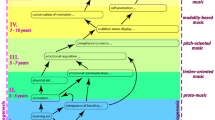Abstract
Ecological conditions and pathogen stress shape human cognition and behavior and can explain cultural and behavioral patterns cross-culturally. It has been previously shown that human values and preferences are also phenotypically plastic in response to parasitic stress across regions, and that parasite prevalence is associated with the out-group prejudice and nonconformity tolerance. Human preference for music is also variable across the world, and no previous study has considered this variability in the light of behavioral ecology. Research has shown that in the regions in which the parasite stress is higher, there is higher aversion against out-groups, and unusual and deviant behaviors. In the current study we hypothesized that extreme forms of music such as heavy metal, which is associated with antisocial behavior, irreligiosity, and deviation from the norm is less prevalent in the regions with higher prevalence of pathogenic stress. We tested our hypothesis using publicly available data measuring number and intensity of metal bands and parasite prevalence while controlling for importance of religion, human development index, and population size across European countries. Results showed that parasite stress negatively predicts the number of heavy metal bands. However, no relationship was found between the intensity of the music and parasite stress. We discussed our results in terms of association of parasite stress with tolerance to out-group members (metal community and culture) and with the openness to new musical endeavors. Overall, this study extends the role of the ecological and biological variation (parasite stress) in shaping human cognition to musical preference and prevalence.
Similar content being viewed by others
Notes
The AIC is a measure of the fit of a model. Its absolute value is meaningless, but comparing AICs from two models allows to determine which one fits the data better.
References
Angeler, D. G. (2016). Heavy metal music meets complexity and sustainability science. SpringerPlus, 5, 1637.
Arnett, J. (1991). Heavy metal music and reckless behavior among adolescents. Journal of Youth and Adolescence, 20(6), 573–592.
Baker, F., & Bor, W. (2008). Can music preference indicate mental health status in young people? Australasian Psychiatry, 16(4), 284–288.
Ballard, M. E., & Coates, S. (1995). The immediate effects of homicidal, suicidal, and nonviolent heavy metal and rap songs on the moods of college students. Youth & Society, 27(2), 148–168.
Ballard, M. E., Dodson, A. R., & Bazzini, D. G. (1999). Genre of music and lyrical content: Expectation effects. The Journal of Genetic Psychology, 160(4), 476–487.
Bogt, T. F. T., Gabhainn, S. N., Simons-Morton, B. G., Ferreira, M., Hublet, A., Godeau, E. (2012). HBSC Risk Behavior and the HBSC Peer Culture Focus Groups. Dance is the new metal: Adolescent music preferences and substance use across Europe. Substance Use & Misuse, 47(2), 130–142.
Butkovic, A., & Rancic Dopudj, D. (2017). Personality traits and alcohol consumption of classical and heavy metal musicians. Psychology of Music, 45(2), 246–256.
Delsing, M. J., Ter Bogt, T. F., Engels, R. C., & Meeus, W. H. (2008). Adolescents' music preferences and personality characteristics. European Journal of Personality, 22(2), 109–130.
Faulkner, J., Schaller, M., Park, J. H., & Duncan, L. A. (2004). Evolved disease-avoidance mechanisms and contemporary xenophobic attitudes. Group Processes & Intergroup Relations, 7(4), 333–353.
Fincher, C. L., & Thornhill, R. (2008). Assortative sociality, limited dispersal, infectious disease and the genesis of the global pattern of religion diversity. Proceedings of the Royal Society of London B: Biological Sciences, 275(1651), 2587–2594.
Fincher, C. L., & Thornhill, R. (2012). Parasite-stress promotes in-group assortative sociality: The cases of strong family ties and heightened religiosity. Behavioral and Brain Sciences, 35(02), 61–79.
Fincher, C. L., Thornhill, R., Murray, D. R., & Schaller, M. (2008). Pathogen prevalence predicts human cross-cultural variability in individualism/collectivism. Proceedings of the Royal Society of London B: Biological Sciences, 275(1640), 1279–1285.
Fontenot, M., & Harriss, C. (2010). Building a better PIG: a historical survey of the PMRC and its tactics. Media, Culture & Society, 32(4), 565–580.
Fried, C. B. (2003). Stereotypes of music fans: are rap and heavy metal fans a danger to themselves or others? Journal of Media Psychology, 8, 2–27.
Gallup (2009). Religiosity Highest in World’s Poorest Nations. Gallup Organization. Retrieved Jan 2014. http://www.gallup.com/.
Kahn-Harris, K. (2007). Extreme metal: Music and culture on the edge. Oxford: Berg.
Kenny, D. T., & Asher, A. (2016). Life expectancy and cause of death in popular musicians: Is the popular musician lifestyle the road to ruin? Medical Problems of Performing Artists, 31(1), 37–44.
King, P. (1988). Heavy metal music and drug abuse in adolescents. Postgraduate Medicine, 83(5), 295–304.
Kurzban, R., & Leary, M. R. (2001). Evolutionary origins of stigmatization: the functions of social exclusion. Psychological Bulletin, 127(2), 187.
Lacourse, E., Claes, M., & Villeneuve, M. (2001). Heavy metal music and adolescent suicidal risk. Journal of Youth and Adolescence, 30(3), 321–332.
Langmeyer, A., Guglhör-Rudan, A., & Tarnai, C. (2012). What do music preferences reveal about personality? Journal of Individual Differences, 33(2), 119–130.
Martin, G., Clarke, M., & Pearce, C. (1993). Adolescent suicide: music preference as an indicator of vulnerability. Journal of the American Academy of Child & Adolescent Psychiatry, 32(3), 530–535.
Miller, K. E., & Quigley, B. M. (2012). Sensation-seeking, performance genres and substance use among musicians. Psychology of Music, 40(4), 389–410.
Morris, M. (2015). Extreme heavy metal music and critical theory. The Germanic Review: Literature, Culture, Theory, 90(4), 285–303.
Petersen, M. B. (2017). Healthy out-group members are represented psychologically as infected in-group members. Psychological Science, 28(12), 1857–1863.
Pollet, T. V., Tybur, J. M., Frankenhuis, W. E., & Rickard, I. J. (2014). What can cross-cultural correlations teach us about human nature? Human Nature, 25(3), 410–429.
R Core Team (2015). R: A language and environment for statistical computing. R Foundation for Statistical Computing, Vienna, Austria. URL https://www.R-project.org/.
Rentfrow, P. J., & Gosling, S. D. (2003). The do re mi's of everyday life: the structure and personality correlates of music preferences. Journal of Personality and Social Psychology, 84(6), 1236.
Schäfer, T., & Mehlhorn, C. (2017). Can personality traits predict musical style preferences? A meta-analysis. Personality and Individual Differences, 116, 265–273.
Schaller, M. (2011). The behavioural immune system and the psychology of human sociality. Philosophical Transactions of the Royal Society of London B: Biological Sciences, 366(1583), 3418–3426.
Schaller, M., & Murray, D. R. (2008). Pathogens, personality, and culture: disease prevalence predicts worldwide variability in sociosexuality, extraversion, and openness to experience. Journal of Personality and Social Psychology, 95(1), 212.
Schaller, M., & Park, J. H. (2011). The behavioral immune system (and why it matters). Current Directions in Psychological Science, 20(2), 99–103.
Shafron, G. R., & Karno, M. P. (2013). Heavy metal music and emotional dysphoria among listeners. Psychology of Popular Media Culture, 2(2), 74.
Stack, S., Gundlach, J., & Reeves, J. L. (1994). The heavy metal subculture and suicide. Suicide and Life-threatening Behavior, 24(1), 15–23.
Swami, V., Malpass, F., Havard, D., Benford, K., Costescu, A., Sofitiki, A., & Taylor, D. (2013). Metalheads: The influence of personality and individual differences on preference for heavy metal. Psychology of Aesthetics, Creativity, and the Arts, 7(4), 377.
Thornhill, R., & Fincher, C. L. (2007). What is the relevance of attachment and life history to political values? Evolution and Human Behavior, 28(4), 215–222.
Thornhill, R., & Fincher, C. L. (2014). The parasite-stress theory of values and sociality: Infectious disease, history and human values worldwide. Springer.
Thornhill, R., Fincher, C. L., Murray, D. R., & Schaller, M. (2010). Zoonotic and non-zoonotic diseases in relation to human personality and societal values: Support for the parasite-stress model. Evolutionary Psychology, 8(2), 151–169.
Took, K. J., & Weiss, D. S. (1994). The relationship between heavy metal and rap music and adolescent turmoil: real or artifact? Adolescence, 29(115), 613.
Tybur, J. M., Inbar, Y., Aarøe, L., Barclay, P., Barlow, F. K., De Barra, M., … & Consedine, N. S. (2016). Parasite stress and pathogen avoidance relate to distinct dimensions of political ideology across 30 nations. Proceedings of the National Academy of Sciences, 113, 12408–12413.
Wass, H., Miller, M. D., & Redditt, C. A. (1991). Adolescents and destructive themes in rock music: a follow-up. OMEGA-Journal of Death and Dying, 23(3), 199–206.
Weinstein, D. (2000). Heavy metal: the music and its culture. New York: De Capo Press.
Acknowledgements
The authors would like to kindly thank Corey Fincher for permission of using parasite data.
Funding
This study was conducted at the Psychology Research Centre (PSI/01662), University of Minho, and supported by the Portuguese Foundation for Science and Technology and the Portuguese Ministry of Science, Technology and Higher Education through national funds and co-financed by FEDER through COMPETE2020 under the PT2020 Partnership Agreement (POCI-01-0145-FEDER-007653). FP receives funding from FCT Portugal through grant SFRH/BD/114366/2016.
Author information
Authors and Affiliations
Corresponding author
Ethics declarations
Competing Interests
The authors declare no competing interests.
Electronic supplementary material
ESM 1
(XLS 31 kb)
Rights and permissions
About this article
Cite this article
Pazhoohi, F., Luna, K. Ecology of Musical Preference: the Relationship Between Pathogen Prevalence and the Number and Intensity of Metal Bands. Evolutionary Psychological Science 4, 294–300 (2018). https://doi.org/10.1007/s40806-018-0139-7
Published:
Issue Date:
DOI: https://doi.org/10.1007/s40806-018-0139-7



